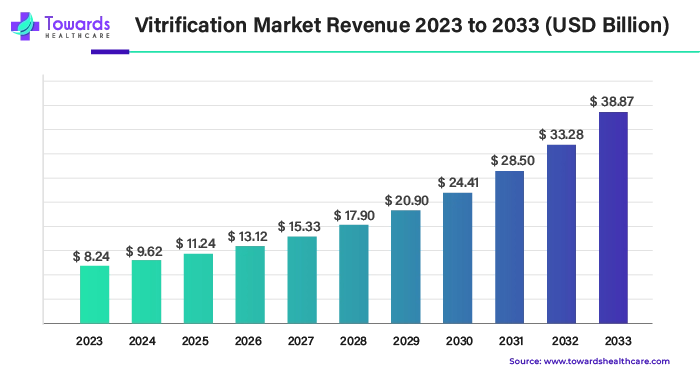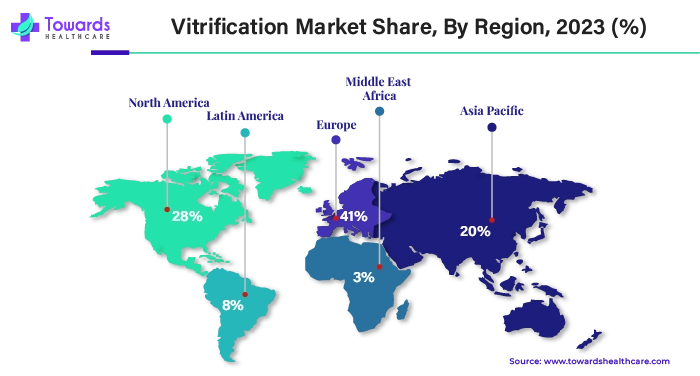April 2025

The global vitrification market size was estimated at US$ 8.24 billion in 2023 and is projected to grow US$ 38.87 billion by 2033, rising at a compound annual growth rate (CAGR) of 16.78% from 2024 to 2033. The global market is expected to rise because of factors including rising knowledge about reproductive health, growing demand for assisted reproductive technologies (ARTs), and an increase in the number of service providers offering vitrification services.

The direct transformation of the liquid phase into a solid that resembles glass is referred to as vitrification. Millions of lives are impacted by the widespread socioeconomic and public health effects of cell and tissue biopreservation. Technologies for cryopreservation offer a practical means of maintaining cells and tissues aimed at the medical setting for use in organ transplantation and reproductive medicine. Of these technologies, vitrification has proven to be the most effective in improving post-thaw cell viability and function over traditional slow-freezing procedures by removing the detrimental effects of ice crystal formation. Due to its high success rate, the vitrification market is expanding, opening doors for young female cancer patients, infertile patients, and anybody else who wants to maintain their fertility. It also makes it possible to create and nurture an oocyte bank.
| Company Name | X-Therma |
| Headquarters | California, U.S. |
| Recent Launch | In March 2024, $22.4m is raised by X-Therma to expand its cryopreservation technology. Through clinical trials and US FDA approval, the company intends to advance its cryopreservation technologies with the help of money. The business intends to use the money to advance the clinical development of its medication and organ preservation technologies as well as to expand its worldwide commercial operations. |
| Company Name | Pluristyx |
| Headquarters | Washington, U.S. |
| Recent Launch | In April 2024, the launch of PluriFreezeTM, a unique cryopreservation medium solution, was announced by Pluristyx, a top supplier of instruments, technology, and services for cellular therapies. PluriFreezeTM is a new addition to Pluristyx's panCELLaTM Platform for iPSC therapeutic development. It is easily applied to other sensitive cell types and is currently available in a Research Use Only (RUO) formulation, with a Good Manufacturing Practice (GMP) version on the horizon. Enhanced post-thaw viability and function can be achieved by using PluriFreezeTM, an innovative solution that facilitates the movement of energetically active cells, including pluripotent stem cells, from the frozen state to the more pliable state. |
Using embryo vitrification is a common method for maintaining fertility in assisted reproductive technologies. Extra good-quality embryos may be obtained and transferred directly after thawing in the following cycle or if the patient is not suitable for fresh embryo transfer due to factors like chemotherapy or an unfavorable uterine environment. This will help to prevent embryo waste and increase the likelihood of pregnancy. Moreover, the vitrification of embryos can reduce the incidence of multiple births and avoid ovarian hyperstimulation syndrome (OHSS).
For instance,
A lot of work has gone into the field of assisted reproduction to determine the safety of cryopreservation of gametes, embryos, and tissues, particularly when using the vitrification process. They could damage a fetus's and the placenta's normal development and function, disrupt the normal establishment and maintenance of genomic imprinting, result in aberrant expression of imprinted genes, have a negative impact on the health of the offspring born after birth, and cause unfavorable pregnancy outcomes. It is important to focus on and continue research on the connection between cryopreservation methods and imprinting problems.
For vitrification, a uniform, automated process is required. It may be possible for automated vitrification to offer a more predictable and consistent process, allowing all operators to produce reliable results. In order to vitrify eggs and embryos, semi-automated Shara and automated Gavi systems have recently been created. These systems have produced comparable in vitro results in people and animals and have a great deal of potential for clinical application. Therefore, improving and standardizing the repeatability of vitrification results would greatly benefit from the creation of an automated system.

The oocytes segment dominated the vitrification market in 2023. Infertility affects a great deal of people at some point in their lives. One in six adults globally, or 17.5% of the population, suffer from infertility, demonstrating the critical need to expand access to high-quality, reasonably priced reproductive care for those who require it. Recent developments in vitrification technology have significantly increased the effectiveness of oocyte cryopreservation in terms of live birth rates and oocyte survival and pregnancy. Infertile couples who disagree with the cryopreservation of embryos due to moral or religious reasons can benefit from oocyte vitrification. Women who want to delay having children in order to focus on their professional jobs may want to think about oocyte vitrification as a possibility. Indeed, in nations where the preservation of embryos through cryopreservation is illegal, one of the most popular methods for conserving female fertility through cryopreservation of oocytes has emerged.
The sperm segment is estimated to grow in the vitrification market at the fastest rate during the predicted period. For many years, the field of assisted reproductive technology (ART) has employed sperm vitrification, which has produced numerous healthy live newborns. Vitrification is a simpler, faster, and less expensive method of preserving human sperm than the traditional slow-freezing approach. Additionally, certain vitrification techniques do not require the use of cryoprotectants, which makes them a viable alternative for sperm cryopreservation. The most popular and effective technique to maintain male fertility when spermatozoa counts are low is through vitrification of human sperm. New tools for sperm vitrification have recently been created in an effort to enhance volume control.
For instance,

The IVF clinics segment led by 61% in the vitrification market in 2023. The intricate set of steps known as in vitro fertilization, or IVF, can result in pregnancy. It is a treatment for infertility, which affects most couples and results in infertility after at least a year of trying. It is also possible to stop genetic issues from being passed on to a child through IVF. The majority of IVF clinics opt for vitrification due to its increased success rate and reliability, especially when it comes to egg freezing. The majority of clinics use this method to guarantee their patients have high success rates because vitrification has been so successful that freezing eggs or embryos is no longer considered experimental.
For instance,
The biobanks segment is expected to grow by 39% in the vitrification market at the fastest rate during 2023-2033. Modern cryopreservation techniques and technologies are at the forefront of research in the fields of personalized medicine, stem cell biology, discovery science, and diagnostic development. With the growing use of cryopreserved cells, the biobanking business is facing more and more demands that are changing and growing more quickly.

Europe held the largest share of 41% in the vitrification market in 2023. This is due to the existence of sophisticated economies like those in France, Spain, Germany, the United Kingdom, and Italy. It is anticipated that cryopreservation techniques will rise significantly in the region due to these countries' sophisticated infrastructure. Moreover, the growth of the industry is facilitated by the financial support provided by the biotechnology sector and the development of assisted reproductive technologies in countries such as Germany and the UK. The key forces for regional development are the high rate of infertility and the growing interest in egg preservation among women.
Infertility affects 1 in 6 couples in Europe, which means that 25 million people in the EU alone require an infertility diagnosis and treatment. This percentage has been claimed by patient and medical associations to be as high as 20% in several European nations. Every year, over 1,200 new egg donor registrations and 100,000 treatment and storage cycles are completed; 99 percent of these cycles are completed without any issues being reported. In the United Kingdom (UK), the Human Fertilisation and Embryology Authority (HFEA) is the autonomous body that oversees fertility treatments and human embryo research.

Asia Pacific is estimated to grow at the fastest CAGR during the forecast period because of elements such as the region's expanding population and rising fertility treatment costs. In the upcoming years, the vitrification market is expected to develop due to a number of factors, including the expanding availability of healthcare facilities and rising public awareness.
Japan has one of the oldest populations in the world, and for a long time, the country's birth rate has been declining. In an attempt to provide nationwide coverage for infertility treatment, the Japanese government has recently undertaken significant efforts, paying a substantial amount of the cost of IVF for up to six cycles. It is expected that these favorable factors will support the market's expansion in the APAC area.
For instance,
By Specimen
By End-use
By Region
April 2025
April 2025
April 2025
April 2025